A Pilot Symbols Aided Adaptive Kalman Filter for Joint Carrier Phase and Polarization Tracking in Coherent Optical System
Abstract
:Featured Application
Abstract
1. Introduction
2. Principle
3. Results
3.1. Simulation Results
3.2. Experimental Results
3.3. The Computational Complexity Analysis
4. Conclusions
Author Contributions
Funding
Conflicts of Interest
References
- Hsiao, W.H.; Huang, C.C. A novel 5G TDD cellular system proposal based on multipath division multiple access. In Proceedings of the 2017 19th International Conference on Advanced Communication Technology (ICACT), PyeongChang, Korea, 19–22 February 2017. [Google Scholar]
- Hu, P.; Ning, H.; Qiu, T.; Song, H.; Wang, Y.; Yao, X. Security and Privacy Preservation Scheme of Face Identification and Resolution Framework Using Fog Computing in Internet of Things. IEEE Internet Things J. 2017, 4, 1143–1155. [Google Scholar] [CrossRef]
- Yang, W.; Wang, M.; Zhang, J.; Zou, J.; Hua, M.; Xia, T.; You, X. A novel 5G TDD cellular system proposal based on multipath division multiple access. Wirel. Commun. 2017, 24, 138–145. [Google Scholar] [CrossRef]
- Hongo, J.; Kasai, K.; Yoshida, M.; Nakazawa, M. 1-Gsymbol/s 64-QAM Coherent Optical Transmission Over 150 km. Photonics Technol. Lett. 2007, 19, 638–640. [Google Scholar] [CrossRef]
- Zhang, J.; Yu, J.; Chi, N.; Li, F.; Li, X. Experimental demonstration of 24-Gb/s CAP-64QAM radio-over-fiber system over 40-GHz mm-wave fiber-wireless transmission. Opt. Express 2013, 21, 26888–26895. [Google Scholar] [CrossRef] [PubMed]
- Jia, Z.; Chien, H.C.; Zhang, J.; Dong, Z.; Cai, Y. Performance Analysis of Pre- and Post-Compensation for Bandwidth-Constrained Signal in High-Spectral-Efficiency Optical Coherent Systems. In Proceedings of the Optical Fiber Communications Conference and Exhibition 2014, San Francisco, CA, USA, 9–13 March 2014. [Google Scholar]
- Zhang, Q.; Wang, M.G. Performance Analysis of Carrier Phase Estimation Algorithm for Coherent Optical Communication System. Electro-Opt. Technol. Appl. 2016, 6, 39–46. [Google Scholar]
- Zhou, X.; Zhong, K.; Gao, Y.; Lu, C.; Lau, A.P.T.; Long, K. Modulation-format-independent blind phase search algorithm for coherent optical square M-QAM systems. Opt. Express 2014, 22, 24044–24054. [Google Scholar] [CrossRef] [PubMed]
- Navarro, J.R.; Kakkar, A.; Schatz, R.; Pang, X.; Ozolins, O.; Udalcovs, A.; Popov, S.; Jacobsen, G. Efficient carrier phase recovery using BPS with angular quantization noise mitigation. Photonics 2017, 4, 37. [Google Scholar] [CrossRef]
- Navarro, J.R.; Udalcovs, A.; Pang, X.; Ozolins, O.; Kakkar, A.; Schatz, R.; Nordwall, F.; Popov, S.; Acobsen, G. High phase noise tolerant circular-64QAM with efficient phase recovery for coherent optical systems. In Proceedings of the Asia Communications and Photonics Conference 2017, Guangzhou, China, 10–13 November 2017. [Google Scholar]
- Louchet, H.; Kuzmin, K.; Richter, A. Improved DSP algorithms for coherent 16-QAM transmission. In Proceedings of the 34th European Conference on Optical Communication 2008, Brussels, Belgium, 21–25 September 2008. [Google Scholar]
- Lau, A.P.T.; Gao, Y.; Sui, Q.; Wang, D.; Lu, C. Beyond 100 Gb/s: Advanced DSP Techniques Enabling High Spectral Efficiency and Flexible Optical Communications. In Proceedings of the Asia Communications and Photonics Conference 2013, Beijing, China, 12–15 November 2013. [Google Scholar]
- Savory, S.J. Digital Coherent Optical Receivers: Algorithms and Subsystems. J. Sel. Top. Quantum Electron. 2010, 16, 1164–1179. [Google Scholar] [CrossRef]
- Savory, S.J. Digital filters for coherent optical receivers. Opt. Express 2008, 16, 804–817. [Google Scholar] [CrossRef] [PubMed]
- Marshall, T.; Szafraniec, B.; Nebendahl, B. Kalman filter carrier and polarization-state tracking. Opt. Lett. 2010, 35, 2203–2205. [Google Scholar] [CrossRef] [PubMed]
- Jiang, W.; Yang, Y.; Zhang, Q.; Sun, Y.; Zhong, K.; Zhou, X.; Yao, Y. Application of Kalman filter in frequency offset estimation for coherent optical quadrature phase-shift keying communication system. Opt. Eng. 2016, 55, 096102. [Google Scholar] [CrossRef]
- Cao, G.; Yang, Y.; Wang, F.; Cui, L.; Ning, R.; Gu, J.; Yao, Y. Extended Kalman based polarization and carrier phase quickly tracking for PDM-16QAM. Acta Opt. Sin. 2014, 53–58. [Google Scholar] [CrossRef]
- Cao, G.; Yang, Y.; Zhong, K.P.; Cui, L.; Ning, R.; Gu, J.; Yao, Y. Assessment of Extended Kalman Filtering Based Simultaneous Polarization and Phase Tracking for PDM-16QAM. In Proceedings of the Asia Communications and Photonics Conference 2014, Shanghai, China, 11–14 November 2014. [Google Scholar]
- Zhang, Q.; Yang, Y. Joint polarization tracking and channel equalization based on radius-directed linear Kalman filter. Opt. Commun. 2018, 407C, 142–147. [Google Scholar] [CrossRef]
- Xiang, Q.; Yao, Y. Fast, accurate, and robust frequency offset estimation based on modified adaptive Kalman filter in coherent optical communication system. Opt. Eng. 2017, 56, 096109. [Google Scholar]
- Xiang, Q.; Yang, Y.; Zhang, Q.; He, Q.; Yao, Y. Adaptive Kalman filter for polarization and phase recovery in wide ranges of optical signal-to-noise ratio, polarization rotation frequency, and laser linewidth. Opt. Eng. 2018, 57, 066107. [Google Scholar] [CrossRef]
- Jiang, W.; Yang, Y.; Cao, G.; Zhong, K.; Yao, Y. Blind and Simultaneous Polarization and Phase Recovery for Time Domain Hybrid QAM Signals Based on Extended Kalman Filtering. In Proceedings of the Asia Communications and Photonics Conference 2015, Hong Kong, China, 19–23 November 2015. [Google Scholar]


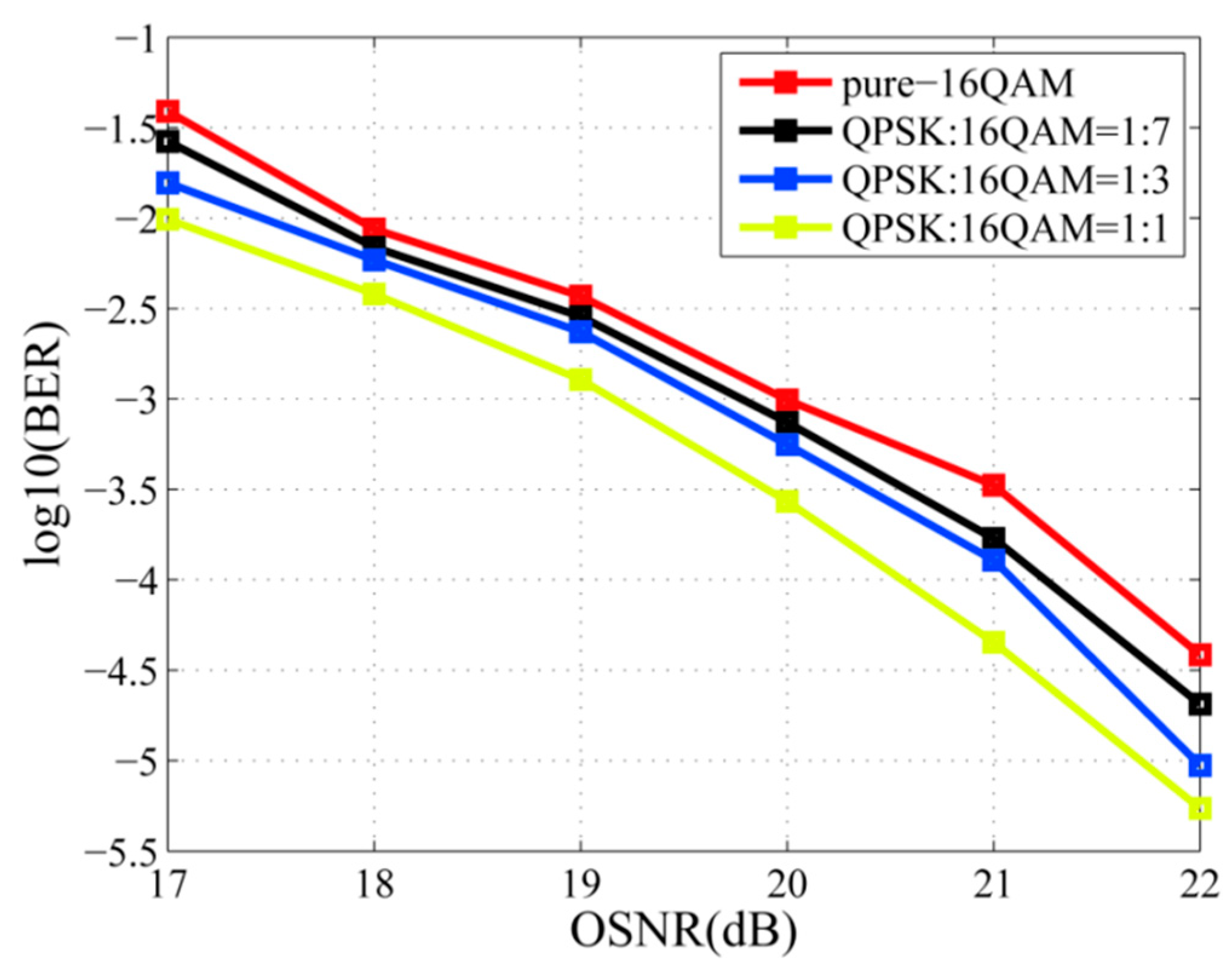
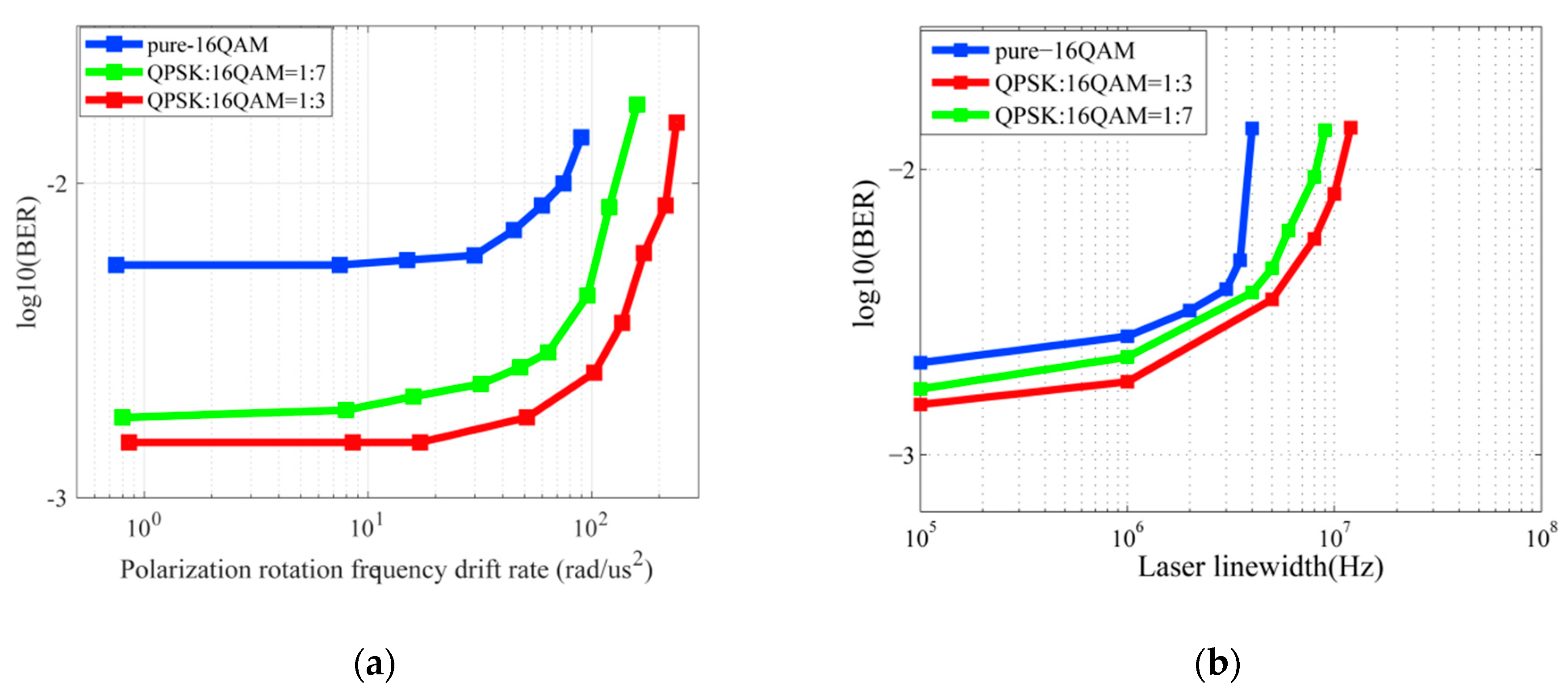
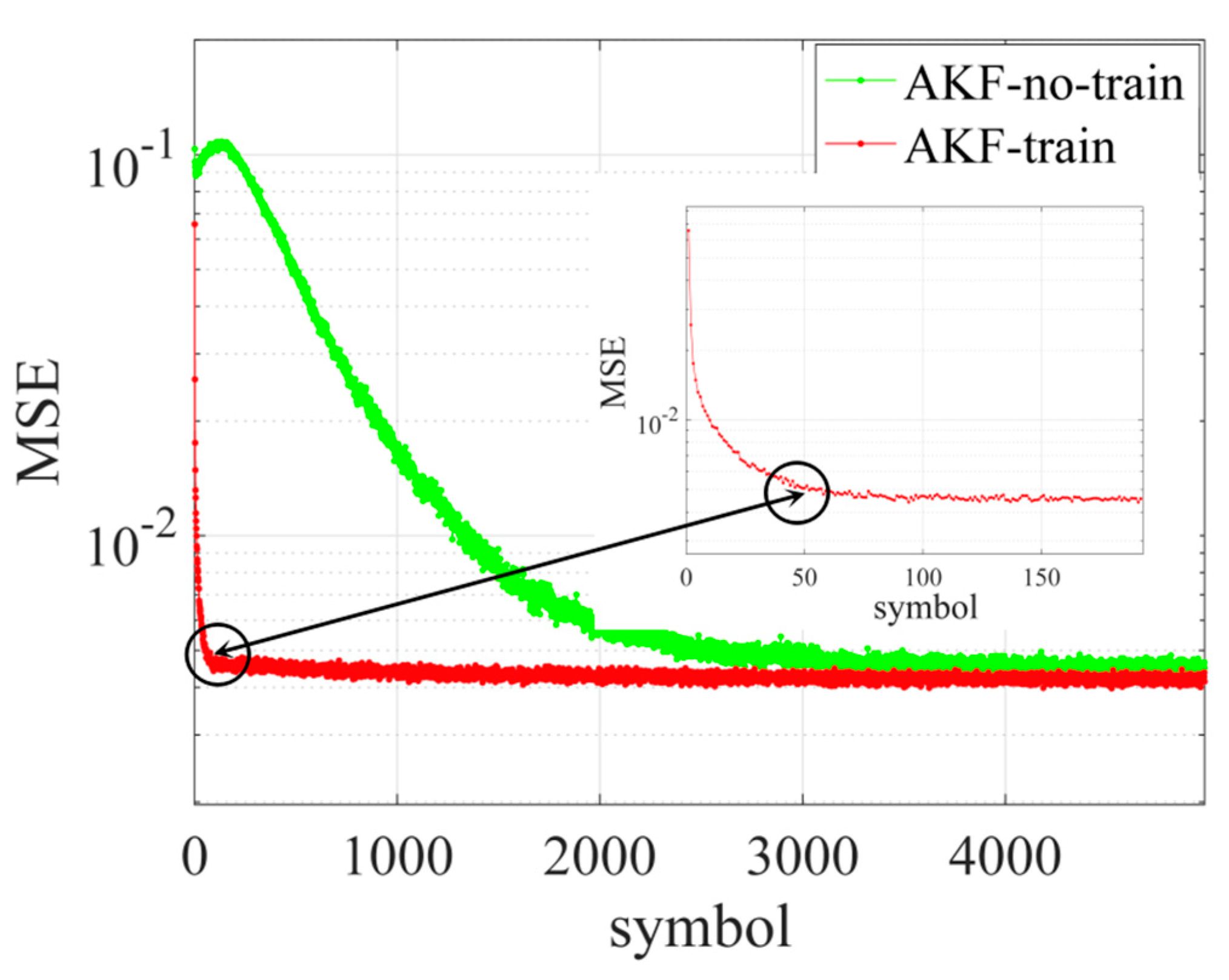
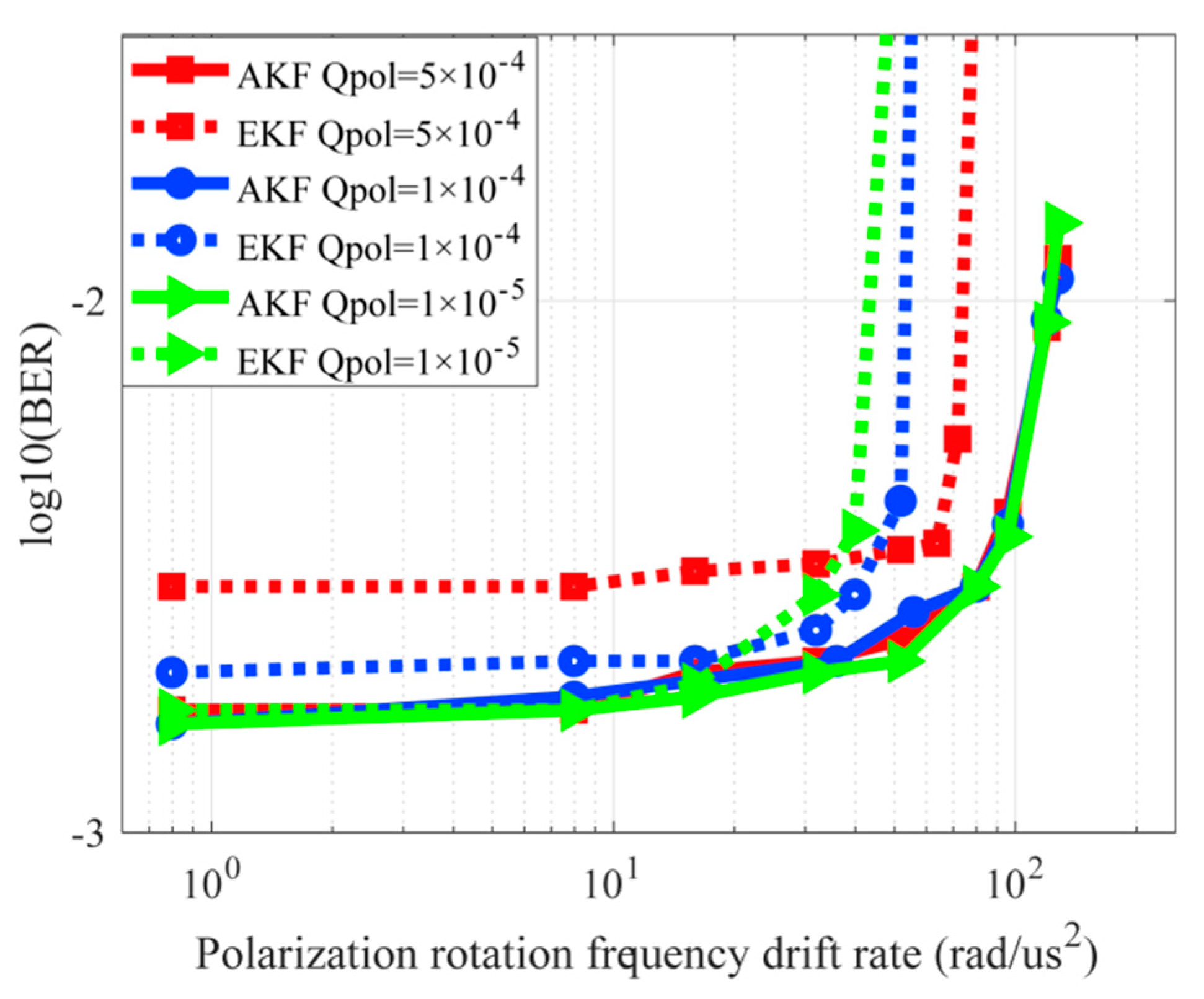
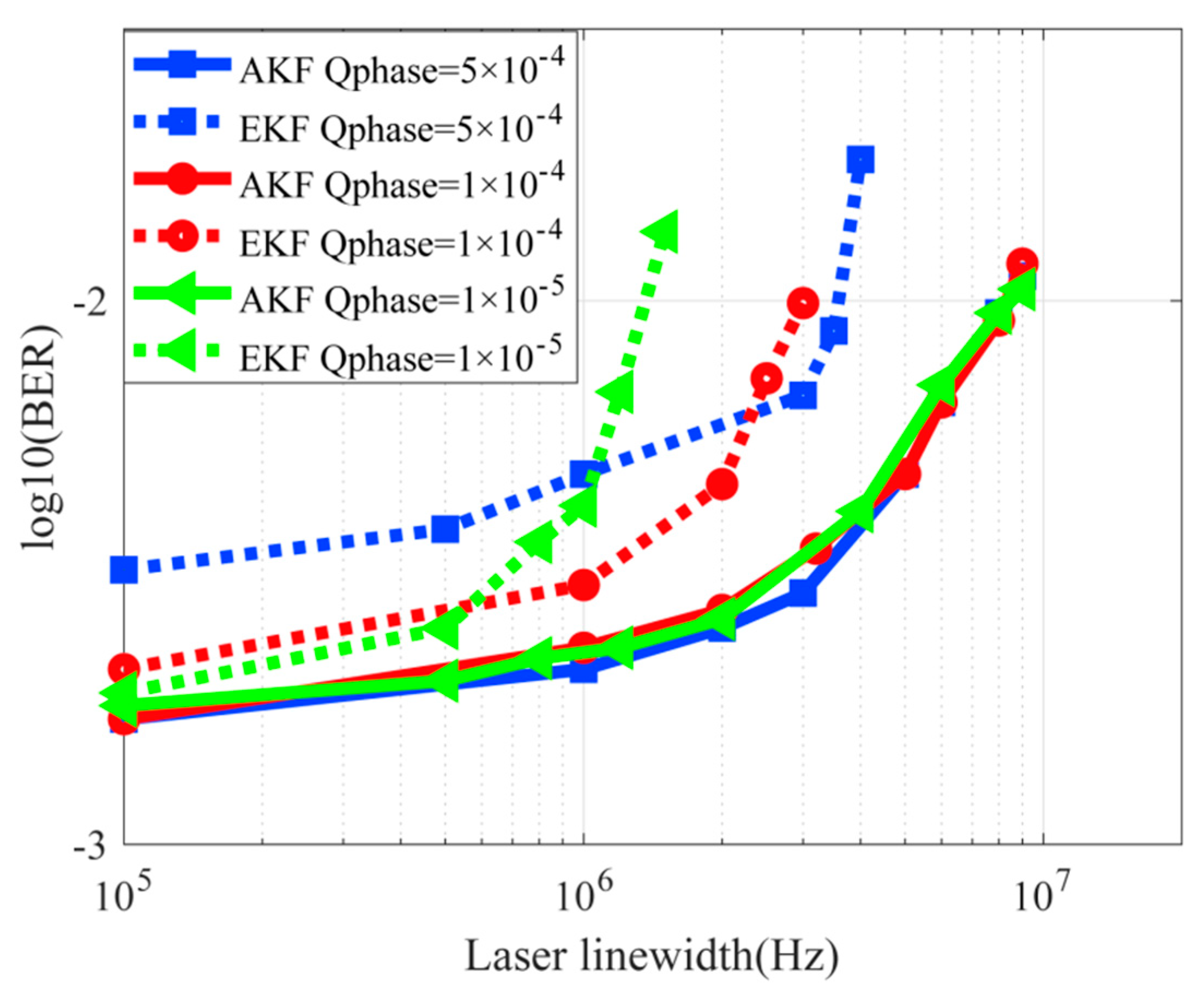
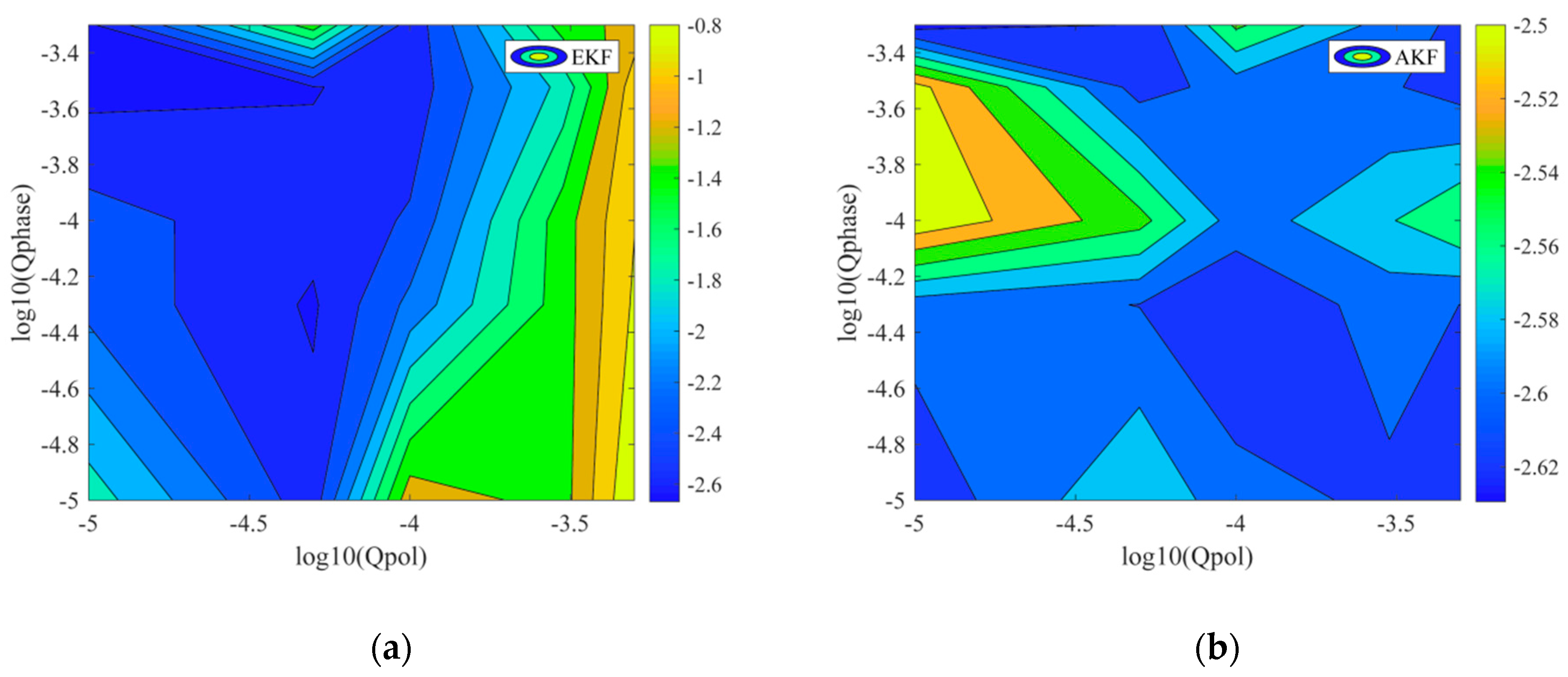

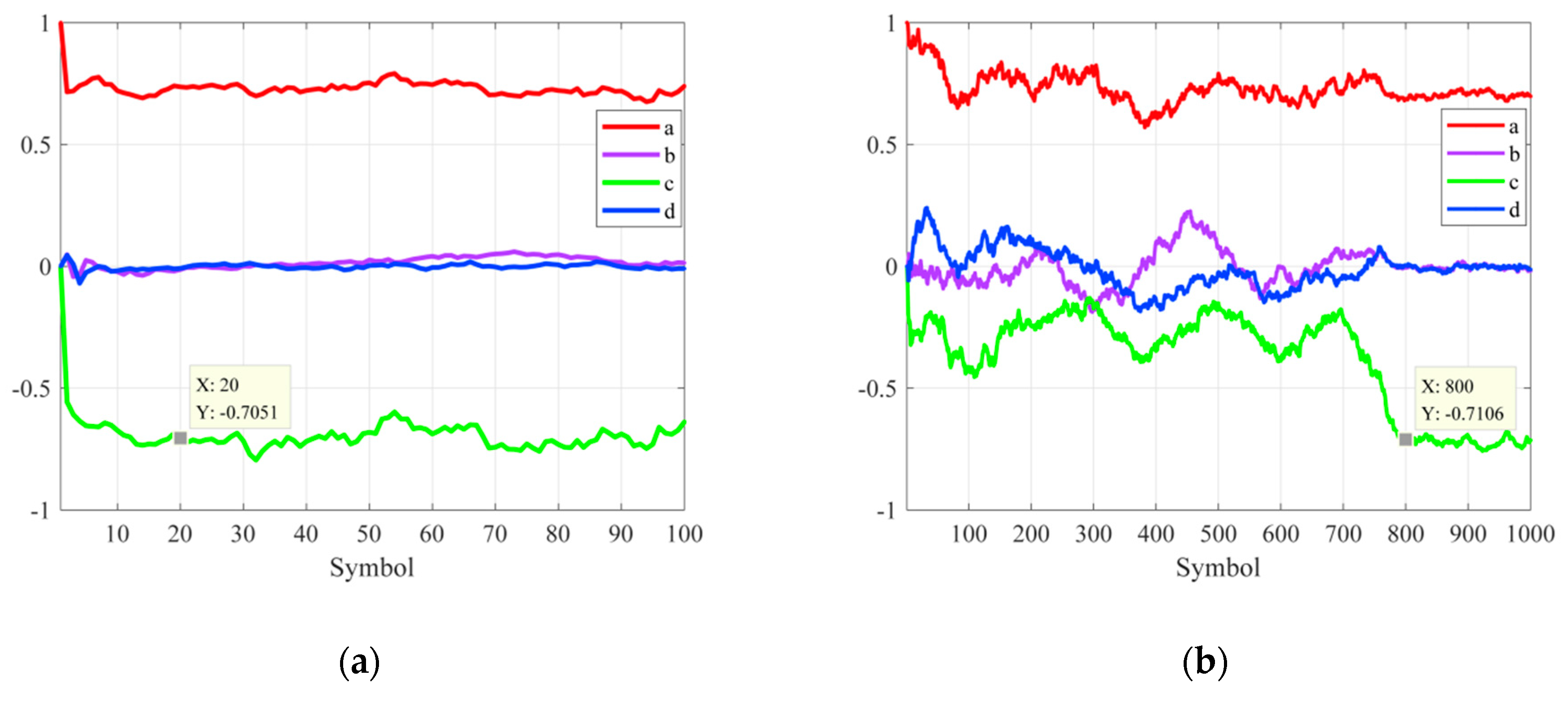
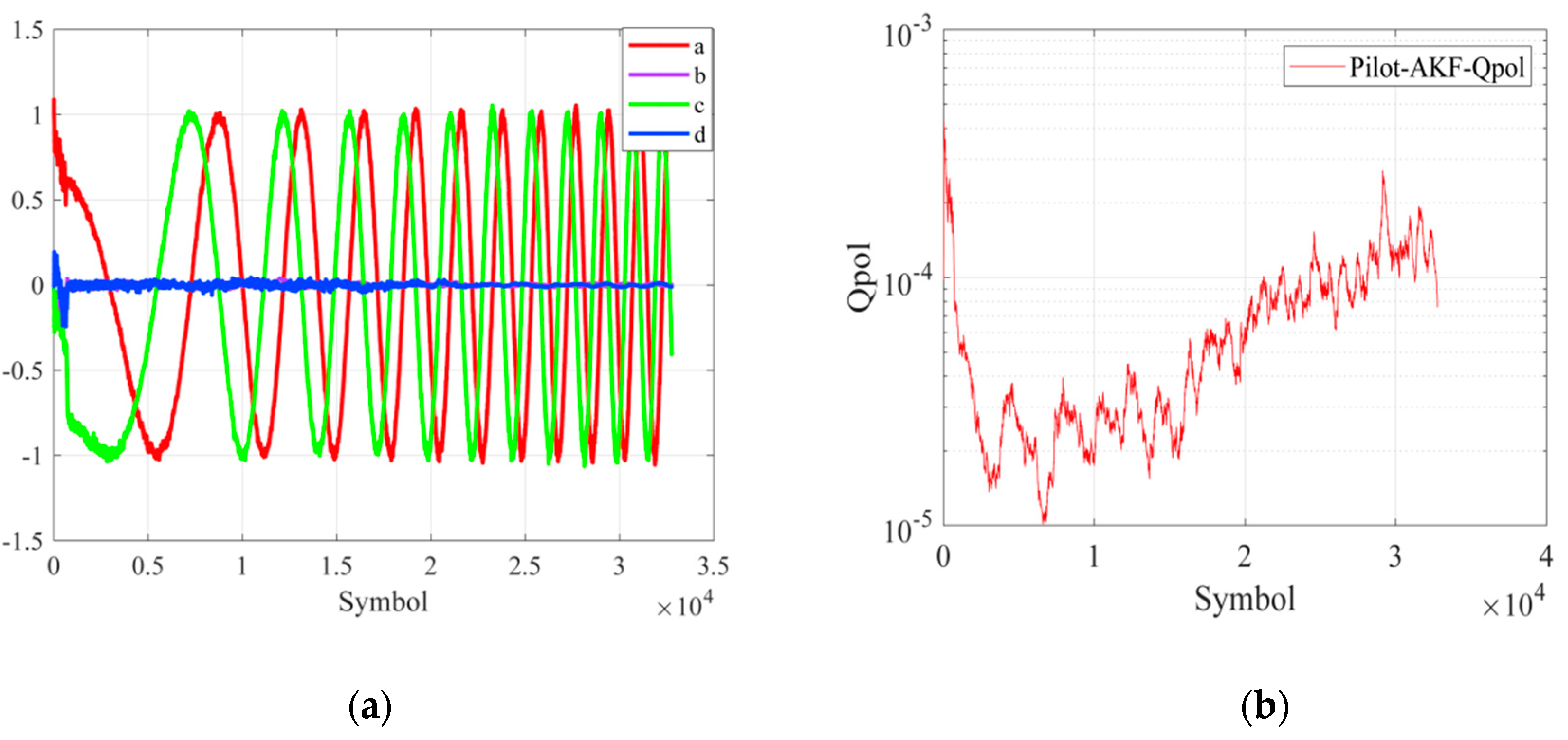
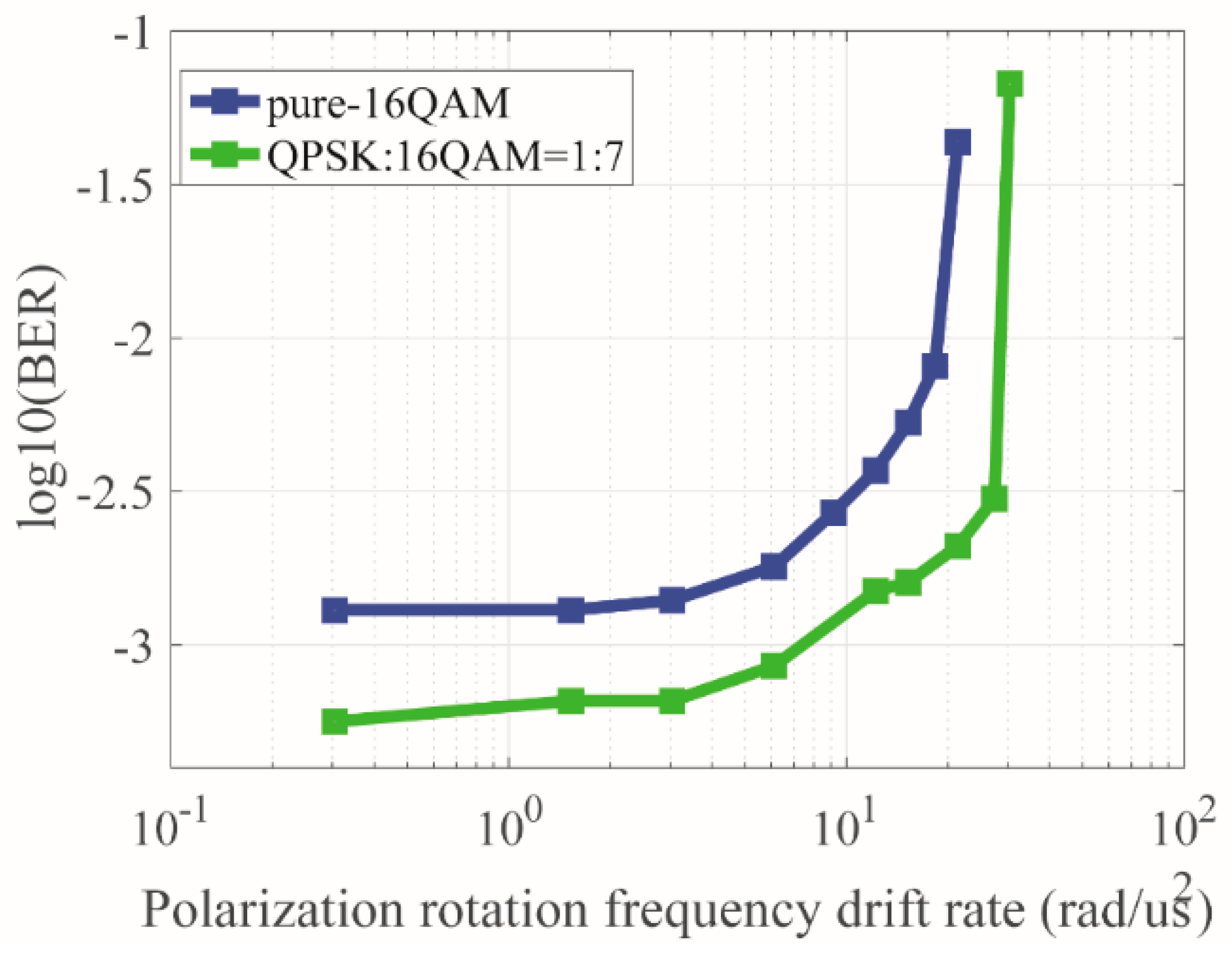
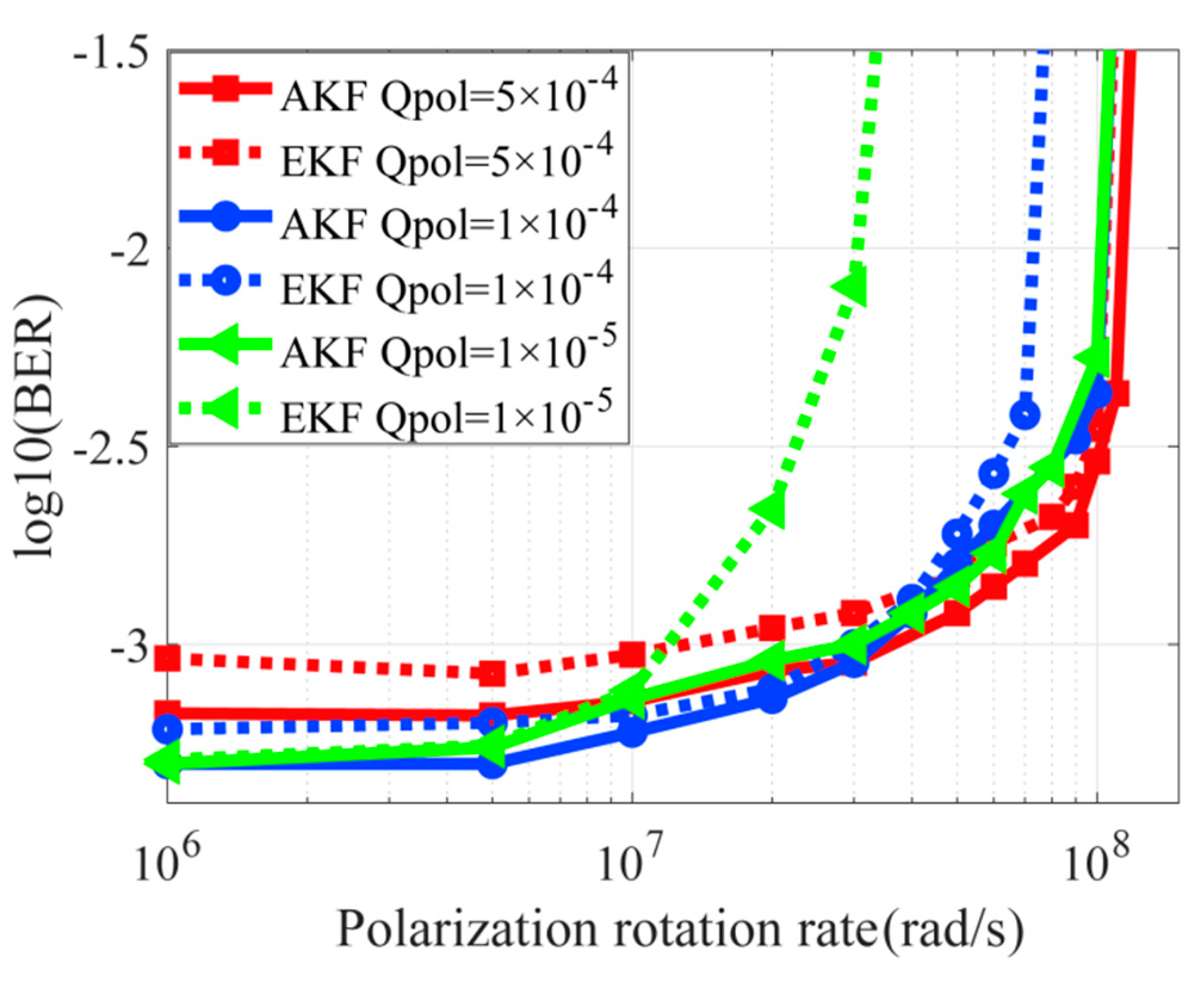
| Our Scheme | CMA+BPS | |
|---|---|---|
| Real multiplication | 585 | 16M+16+6NB+4N |
| Real addition | 459 | 16M+4+6NB-B+2N+2 |
| Comparison | 0 | B |
| LUT | 32 | 0 |
© 2018 by the authors. Licensee MDPI, Basel, Switzerland. This article is an open access article distributed under the terms and conditions of the Creative Commons Attribution (CC BY) license (http://creativecommons.org/licenses/by/4.0/).
Share and Cite
Cao, J.; Yang, Y.; Xiang, Q.; Zhang, Q.; Fan, L.; Yao, Y. A Pilot Symbols Aided Adaptive Kalman Filter for Joint Carrier Phase and Polarization Tracking in Coherent Optical System. Appl. Sci. 2019, 9, 27. https://doi.org/10.3390/app9010027
Cao J, Yang Y, Xiang Q, Zhang Q, Fan L, Yao Y. A Pilot Symbols Aided Adaptive Kalman Filter for Joint Carrier Phase and Polarization Tracking in Coherent Optical System. Applied Sciences. 2019; 9(1):27. https://doi.org/10.3390/app9010027
Chicago/Turabian StyleCao, Juntao, Yanfu Yang, Qian Xiang, Qun Zhang, Linsheng Fan, and Yong Yao. 2019. "A Pilot Symbols Aided Adaptive Kalman Filter for Joint Carrier Phase and Polarization Tracking in Coherent Optical System" Applied Sciences 9, no. 1: 27. https://doi.org/10.3390/app9010027
APA StyleCao, J., Yang, Y., Xiang, Q., Zhang, Q., Fan, L., & Yao, Y. (2019). A Pilot Symbols Aided Adaptive Kalman Filter for Joint Carrier Phase and Polarization Tracking in Coherent Optical System. Applied Sciences, 9(1), 27. https://doi.org/10.3390/app9010027





